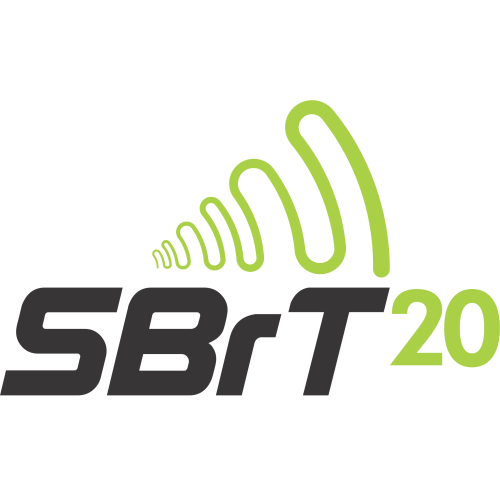
XXXVIII Simpósio Brasileiro de Telecomunicações e Processamento de Sinais
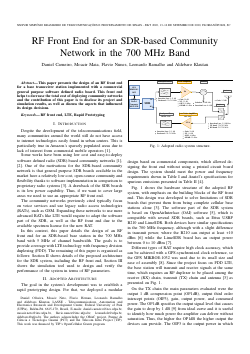
RF Front End for an SDR-based Community Network in the 700 MHz Band
Daniel Oliveira Carneiro, Moacir Brito Maia Neto, Leonardo Ramalho, Flavio Nunes, Aldebaro Klautau
DOI: 10.14209/SBRT.2020.1570658206
Keywords: RF front end LTE Rapid Prototyping
Abstract
This paper presents the design of an RF front end for a base transceiver station implemented with a commercial general purpose software defined radio board. This front end helps to decrease the total cost of deploying community networks and the contribution of this paper is to disclose its project and simulation results, as well as discuss the aspects that influenced its design decisions.Download
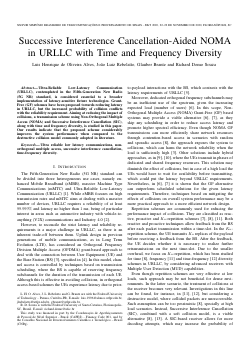
Successive Interference Cancellation-Aided NOMA in URLLC with Time and Frequency Diversity
Luis Alves, João Luiz Rebelatto, Glauber Brante, Richard Demo Souza
DOI: 10.14209/SBRT.2020.1570658207
Keywords: Ultra reliable low latency communications Non-orthogonal multiple access Successive interference cancellation Time-frequency diversity
Abstract
Ultra-Reliable Low-Latency Communication (URLLC), contemplated in the Fifth-Generation New Radio (5G NR) standard, is considered essential to a broader implementation of latency-sensitive future technologies. Grant-Free (GF) schemes have been proposed towards reducing latency in URLLC, but the increased probability of collision conflicts with the reliability requirement. Aiming at reducing the impact of collisions, a transmission scheme using Non-Orthogonal Multiple Access (NOMA) and Successive Interference Cancellation (SIC), along with time and frequency diversity, is studied in this paper. Our results indicate that the proposed scheme considerably improves the system performance when compared to the destructive collision model commonly adopted in literature.Download

Um Novo Algoritmo de Criptografia Caótica Utilizando Técnicas de Ordenação a Partir da Medida Invariante
Murilo D. B. Cruz, Everton Granemann Souza, Chiara das Dores do Nascimento
DOI: 10.14209/SBRT.2020.1570658211
Keywords: Criptografia Caos Algoritmos de Ordenação Mapa Logístico
Abstract
A criptografia caótica é uma maneira eficiente de criptografar textos, porque utiliza recursos de embaralhamento intrínsecos do atrator. Neste trabalho, é apresentado um algoritmo gerador de números pseudo-aleatórios utilizando o mapa logístico. Sua estrutura é baseada no protocolo de Baptista, e utiliza partições da medida natural associadas a caracteres alfanuméricos. Simulações mostram que a implementação de métodos de ordenação, como BubbleSort, QuickSort, e QuickSort/Etaoin, tornam o algoritmo de encriptação mais rápido que o protocolo de Baptista, com destaque ao QuickSort. A encriptação mostrou um nível de segurança aceitável nos testes de Wald-Wolfowitz e eficácia para mensagens longas.Download
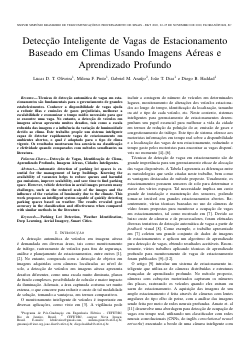
Detecção Inteligente de Vagas de Estacionamento Baseado em Climas Usando Imagens Aéreas e Aprendizado Profundo
Lucas D. T. Oliveira, Milena Pinto, Gabriel Araujo, João T Dias, Diego Haddad
DOI: 10.14209/SBRT.2020.1570658218
Keywords: Detecção de Vagas Identificação de Clima Aprendizado Profundo Imagens Aéreas
Abstract
Automatic detection of parking lot spaces is essential for the management of large buildings. Knowing the availability of vacancies helps to reduce queues and harmful gas emissions, improve scalability, and save time to find parking space. However, vehicle detection in aerial images presents many challenges, such as the reduced scale of the images and the influence of the variation of luminosity due to the climate. This work proposes an intelligent system capable of quickly detecting parking spaces based on weather. The results revealed good accuracy in the classification and effectiveness when compared with similar methods in the literature.Download
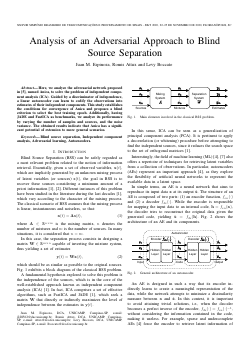
Analysis of an Adversarial Approach to Blind Source Separation
Juan Manuel Espinoza Bullón, Romis Ribeiro Attux, Levy Boccato
DOI: 10.14209/SBRT.2020.1570658229
Keywords: Blind Source Separation Independent Component Analysis Adversarial Learning Autoencoders
Abstract
In this work, we analyze the adversarial network proposed by Brakel and Bengio at [5] to solve the problem of independent component analysis (ICA). Guided by a discriminator of independence, a linear autoencoder learns to codify a set of samples into estimates of their independent components. This is achieved by training the autoencoder to "fool the discriminator" and generate a code of latent variables. The present study focuses on linear mixtures, having the JADE and FastICA algorithms as benchmarks, but the paradigm has a significant potential of extension to more general scenarios.Download
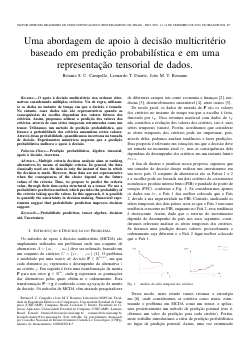
Uma abordagem de apoio à decisão multicritério baseado em predição probabilística e em uma representação tensorial de dados
Betania Silva Carneiro Campello, Leonardo Tomazeli Duarte, João Romano
DOI: 10.14209/SBRT.2020.1570658231
Keywords: Predição probabilística álgebra tensorial apoio à decisão incerteza
Abstract
Multiple criteria decision analysis aims at ranking alternatives by means of multiple criteria. In general, the data classically used are the data in only the instant of time in which the decision is made. However, these data are not representative when the consequences of the choice depend on the future data of the criteria. Thus, we propose to predict the criteria value, through their time-series structured as a tensor. We use a probabilistic prediction method, which provides the probability of the criteria taking specific values. In this approach, it is possible to quantify the uncertainty in decision making. Numerical experiments suggest that probabilistic prediction improves decision support.Download
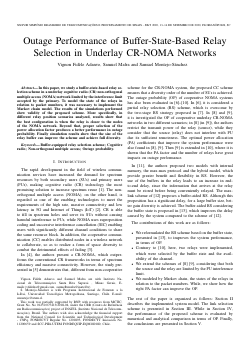
Outage Performance of Buffer-State-Based Relay Selection in Underlay CR-NOMA Networks
Vignon Fidele Adanvo Jr, Samuel Mafra, Samuel Montejo-Sánchez
DOI: 10.14209/SBRT.2020.1570658236
Keywords: Buffer-equipped relay selection scheme Cognitive radio Non-orthogonal multiple access Outage probability
Abstract
In this paper, we study a buffer-state-based relay selection scheme in a underlay cognitive radio (CR) non-orthogonal multiple access (NOMA) network limited by the interference limit accepted by the primary. To model the state of the relays in relation to packet numbers, it was necessary to implement the Markov chain model. The results of the simulations performed show validity of the proposed scheme. More specifically, in different relay position scenarios analyzed, results show that the best configuration is when the relay is closer to the nodes of the NOMA network. Beyond that, proper selection of the power allocation factor produces a better performance in outage probability. Finally simulation results show that the size of the relay buffer can improve the scheme and achieve full diversity.Download
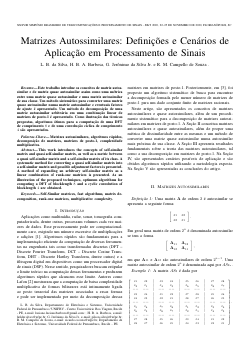
Matrizes Autossimilares: Definições e Cenários de Aplicação em Processamento de Sinais
Luciano Barboza Silva, Hélder Barbosa, Gilson Jerônimo da Silva Jr., Ricardo M Campello de Souza
DOI: 10.14209/SBRT.2020.1570658238
Keywords: Matrizes autossimilares Algoritmos rápidos Matrizes de posto-1
Abstract
This work introduces the concepts of self-similar matrix and quasi self-similar matrix, as well as a metric between a quasi self-similar matrix and a self-similar matrix of its class. A systematic method for converting a quasi self-similar matrix into a self-similar matrix and possible adjustment factors is presented. A method of expanding an arbitrary self-similar matrix as a linear combination of rank-one matrices is presented. As an illustration of the proposed techniques, optimum algorithms for computing a DFT of blocklength 8 and a cyclic convolution of blocklength 4 are obtained.Download
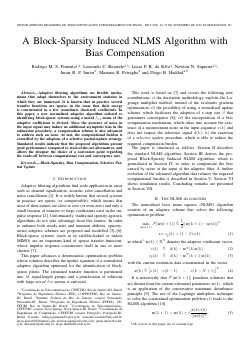
A Block-Sparsity Induced NLMS Algorithm with Bias Compensation
Rodrigo M.S. Pimenta, Leonardo Resende, Lucas da Silva, Newton Siqueira, Jurair Rosa, Mariane R Petraglia, Diego B. Haddad
DOI: 10.14209/SBRT.2020.1570658250
Keywords: Block-Sparsity Bias Compensation Selective Partial Update
Abstract
Adaptive filtering algorithms are flexible mechanisms that adapt themselves to the environment statistics in which they are immersed. It is known that in practice several transfer functions are sparse, in the sense that their energy is concentrated in a few (sometimes clustered) coefficients. In this paper, a new normalized adaptive algorithm tailored to identifying block-sparse systems using a mixed ℓ2,0-norm of the adaptive coefficients is devised. Since the presence of noise in the input signal may induce an additional asymptotic bias in the estimation procedure, a compensation scheme is also advanced to address such an issue. At last, the computational burden is controlled by the adoption of a selective partial-update strategy. Simulated results indicate that the proposed algorithms present good performance compared to state-of-the-art alternatives, and allows the designer the choice of a convenient point regarding the trade-off between computational cost and convergence rate.Download
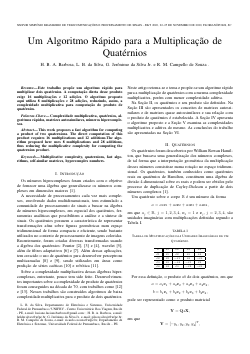
Um Algoritmo Rápido para a Multiplicação de Quatérnios
Luciano Barboza Silva, Hélder Barbosa, Gilson Jerônimo da Silva Jr., Ricardo M Campello de Souza
DOI: 10.14209/SBRT.2020.1570658256
Keywords: Quaternions Fast algorithms Self-similar matrices Hypercomplex numbers
Abstract
This work proposes a fast algorithm for computing a product of two quaternions. The direct computation of this product requires 16 multiplications and 12 additions. The algorithm proposed here uses 8 multiplications and 28 additions, thus reducing the multiplicative complexity for computing the quaternion product.Download